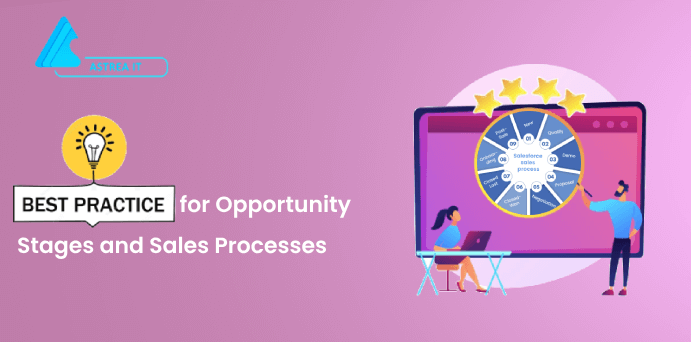Introduction:
In the dynamic world of sales, where competition is fierce and customer expectations are ever-evolving, having a well-defined sales process with effective opportunity stages is crucial for success. A streamlined sales process not only helps in managing leads more efficiently but also ensures a consistent and measurable approach to converting prospects into loyal customers. In this blog, we will explore the best practices related to opportunity stages and sales processes that can elevate your sales team's performance and drive sustainable business growth.

1. Understand Your Buyer's Journey:
Before defining your opportunity stages, it's imperative to understand your buyer's journey. Recognize the various touch points where prospects interact with your business – from initial awareness to the final purchase decision. By aligning your opportunity stages with the stages of the buyer's journey, you create a more customer-centric and intuitive sales process.
2. Define Clear Opportunity Stages:
Create a clear and concise set of opportunity stages that reflect the progression of a lead through the sales funnel. Common stages include "Prospecting," "Qualification," "Needs Analysis," "Proposal/Quote," "Negotiation," and "Closed-Won." Customize these stages based on your industry, product/service, and customer behavior. The goal is to have a standardized framework that every team member can understand and follow.
3. Implement Sales Automation Tools:
Leverage technology to automate repetitive tasks and streamline your sales process. Sales automation tools can help in tracking and managing leads, sending automated follow-up emails, and providing insights into customer behavior. By automating routine tasks, your sales team can focus on building relationships and closing deals.
4. Establish Clear Criteria for Each Stage:
Clearly define the criteria that determine when a lead moves from one stage to the next. This ensures consistency in evaluating and categorizing opportunities. Criteria may include budget approval, decision-maker identification, or completion of a product demo. Regularly review and update these criteria to adapt to changing market conditions and customer expectations.
5. Create a Sales Process
Sales Process is the Salesforce term for the different steps, or stages, that a donation (or other Opportunity type) moves through. For example, a donation may start as Prospecting, then become either Closed/Won or Closed/Lost. A Grant could begin as LOI Submitted, then move to Application Submitted, then (hopefully) become Awarded.
6. Empower Sales Reps with Training:
Sales representatives play a pivotal role in the success of any sales process. Provide comprehensive training to your sales team to ensure they understand the opportunity stages, criteria, and the overall sales process. Equip them with the knowledge and skills required to engage effectively with prospects at each stage, addressing their needs and concerns.
7. Encourage Collaboration Between Sales and Marketing:
Sales and marketing alignment is essential for a seamless sales process. Collaborate with the marketing team to ensure that the leads generated align with the defined opportunity stages. Implement lead scoring mechanisms that help prioritize leads based on their readiness to make a purchase. This collaboration enhances the quality of leads entering the sales funnel.
8. Regularly Analyze and Optimize:
Continuous improvement is the key to sustained success in sales. Regularly analyze the performance of your opportunity stages and sales process. Use key performance indicators (KPIs) such as conversion rates, average deal size, and sales cycle length to identify areas for improvement. Solicit feedback from the sales team and customers to make informed adjustments.
9. Emphasize Customer-Centric Selling:
Shift the focus from product-centric selling to customer-centric selling. Tailor your approach to meet the unique needs and preferences of each customer. Understanding the pain points and motivations of your prospects at each opportunity stage allows your sales team to provide personalized solutions and build stronger relationships.
Conclusion
In the fast-paced world of sales, mastering opportunity stages and sales processes is essential for sustainable growth. By aligning with the buyer's journey, defining clear stages, leveraging technology, empowering your team, fostering collaboration, and emphasizing continuous improvement, you create a foundation for success. Implementing these best practices will not only enhance the efficiency of your sales process but also contribute to building lasting relationships with your customers. Stay agile, adapt to change, and watch your sales team thrive in today's competitive landscape.
For any queries please reach out to support@astreait.com